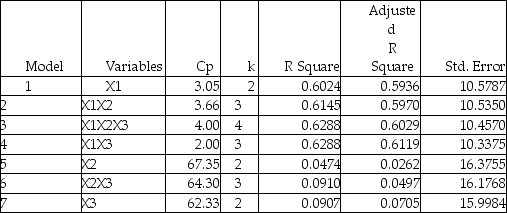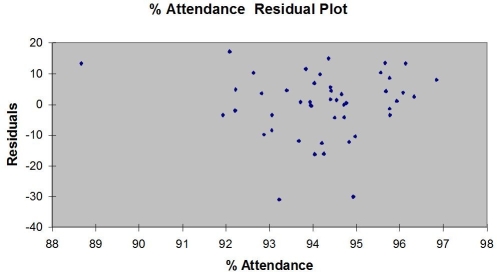TABLE 15-4
The superintendent of a school district wanted to predict the percentage of students passing a sixth-grade proficiency test.She obtained the data on percentage of students passing the proficiency test (% Passing),daily mean of the percentage of students attending class (% Attendance),mean teacher salary in dollars (Salaries),and instructional spending per pupil in dollars (Spending)of 47 schools in the state.
Let Y = % Passing as the dependent variable,X1 = % Attendance,X2 = Salaries and X3 = Spending.
The coefficient of multiple determination (  )of each of the 3 predictors with all the other remaining predictors are,respectively,0.0338,0.4669,and 0.4743.
)of each of the 3 predictors with all the other remaining predictors are,respectively,0.0338,0.4669,and 0.4743.
The output from the best-subset regressions is given below:  Following is the residual plot for % Attendance:
Following is the residual plot for % Attendance:  Following is the output of several multiple regression models:
Following is the output of several multiple regression models:
Model (I):  Model (II):
Model (II):  Model (III):
Model (III): 
-True or False: Referring to Table 15-4,there is reason to suspect collinearity between some pairs of predictors.
Definitions:
Dividends
Payments made by a corporation to its shareholder members, often derived from the company's profits.
Accounting Equation
The foundation of double-entry bookkeeping, stating that Assets = Liabilities + Owners' Equity.
Excess Space
Excess space refers to the additional or unused space within a property or facility that exceeds the current needs of the occupants or users.
Materiality Constraint
An accounting principle that allows for the exclusion of insignificant financial information from reports because it would not impact decision-making.
Q19: Referring to Table 16-15,what are the simple
Q25: True or False: In selecting a forecasting
Q27: Referring to Table 17-9,what is the correct
Q41: True or False: The Laspeyres price index
Q42: Referring to Table 17-8,what are the lower
Q51: Referring to Table 17-10,Model 1,_ of the
Q65: Referring to Table 13-4,suppose the managers of
Q66: Referring to Table 13-3,the total sum of
Q109: True or False: Referring to Table 14-10,to
Q207: Referring to Table 13-2,what is <img src="https://d2lvgg3v3hfg70.cloudfront.net/TB2970/.jpg"